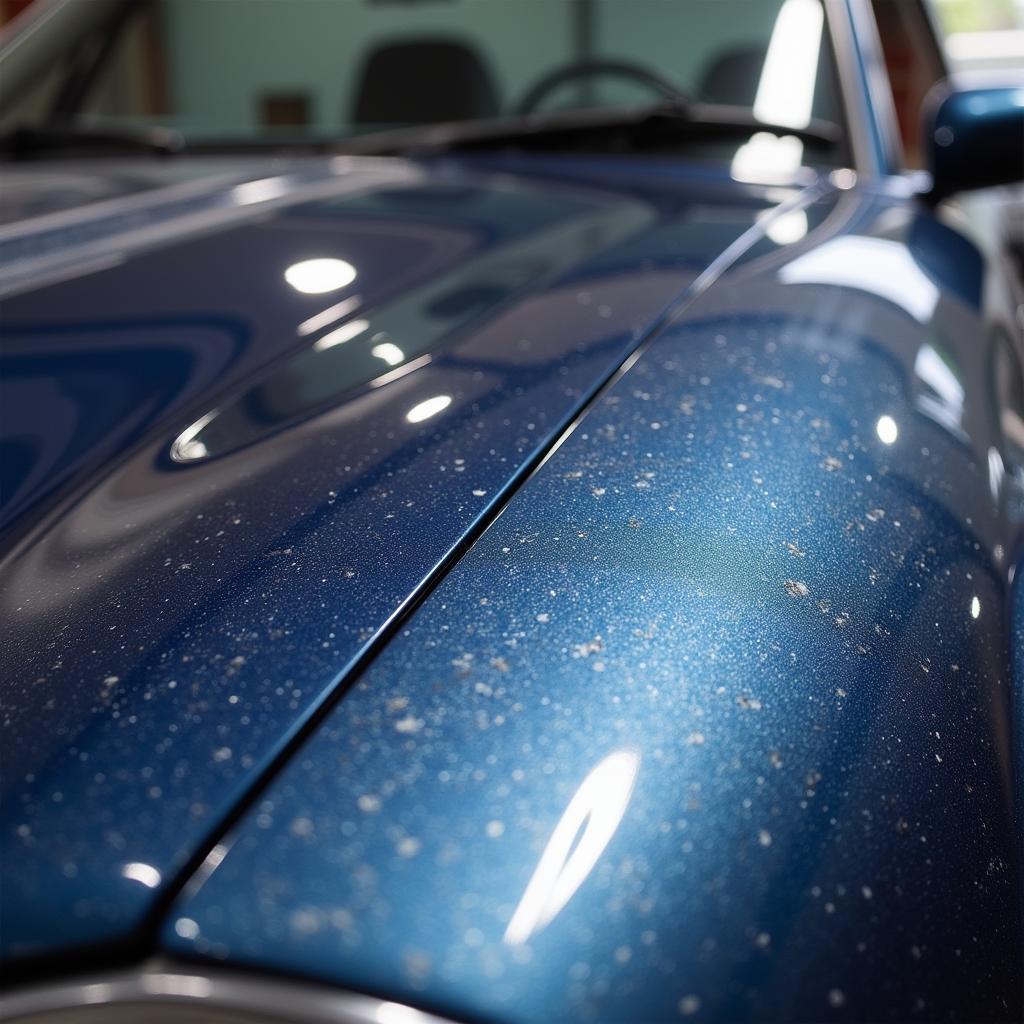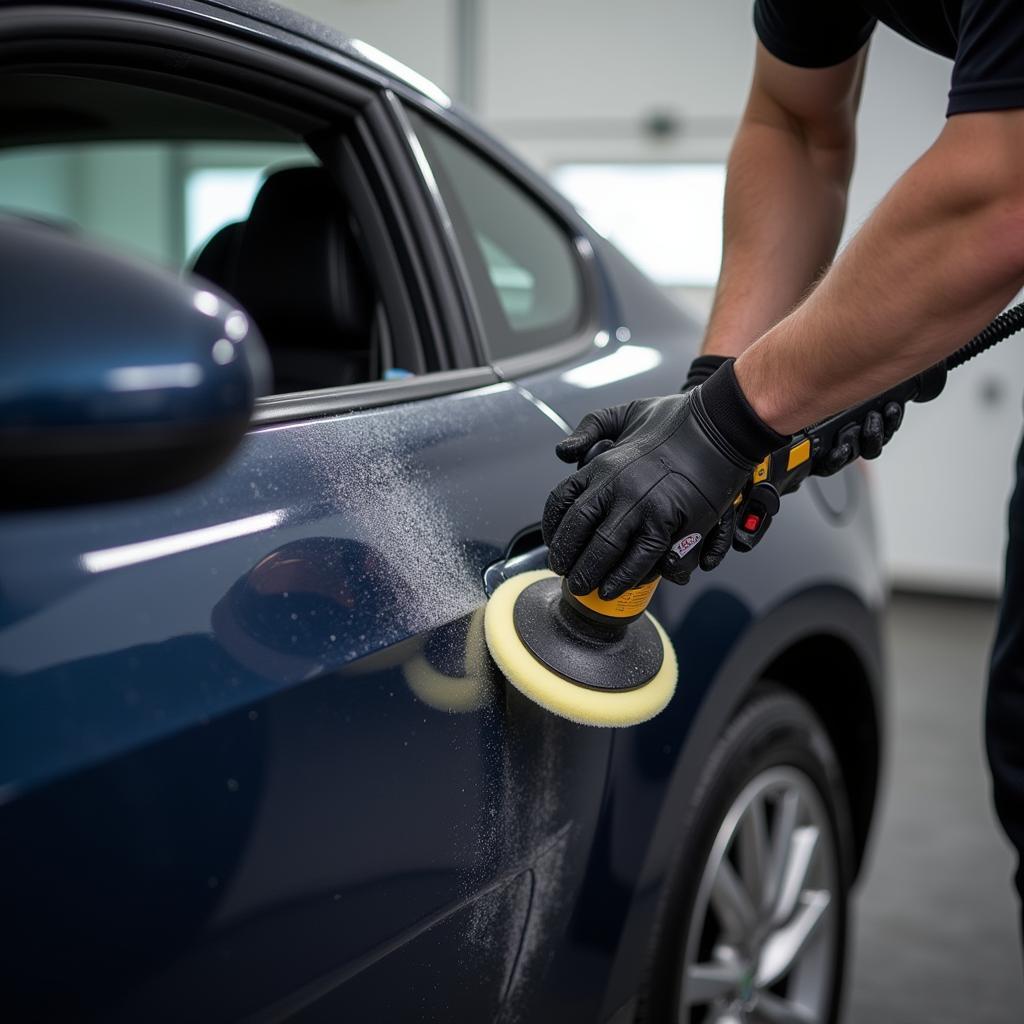A “Car Detail Has Fine Marks” often indicates minor imperfections on your vehicle’s paintwork. These can be frustrating, especially after a fresh detail, but understanding their causes and how to address them can keep your car looking pristine. This article delves into the common culprits behind these fine marks, offering professional advice on prevention and removal.
Decoding Fine Marks on Your Car’s Paint
Fine marks can manifest in various forms, from light swirling and scratches to etching and holograms. These imperfections, often only visible under certain lighting conditions, detract from the overall finish of your vehicle. They can be caused by improper washing techniques, environmental factors, or even the detailing process itself. Addressing these marks requires understanding their origin and employing the right corrective measures.
After a wash, it’s crucial to dry your car thoroughly using a high-quality microfiber towel. This minimizes the risk of water spots and further scratching. For stubborn dirt or contaminants, consider using a clay bar treatment to gently lift them off the surface without causing further damage. Learn more about car detailing techniques on our car detail youtube page.
Common Culprits Behind Fine Marks
One of the most common causes of fine marks is improper washing and drying. Using abrasive materials, such as old towels or sponges, can create micro-scratches, dulling the paint’s shine. Similarly, automated car washes with harsh brushes can inflict significant damage over time. Environmental factors, such as dust, pollen, and bird droppings, can also etch into the paint, leaving behind noticeable marks.
Even professional detailing, if not performed correctly, can introduce fine marks. Using aggressive polishing compounds or incorrect buffing techniques can create swirl marks or holograms. These are often circular or spiderweb-shaped patterns that become especially visible under direct sunlight. Protecting your paint from these imperfections requires meticulous care and attention to detail.
 Fine Marks on Car Paint After Detailing
Fine Marks on Car Paint After Detailing
Preventing Fine Marks: Proactive Car Care
Preventing fine marks begins with proper washing techniques. Use the two-bucket method – one with soapy water and another with clean rinse water – to minimize the risk of dragging dirt across the paint. Opt for high-quality microfiber wash mitts and drying towels to avoid introducing scratches. Regularly waxing or applying a sealant provides an additional layer of protection against environmental contaminants.
When choosing a car detailer, look for experienced professionals who use high-quality products and techniques. Ask about their process and the steps they take to minimize the risk of introducing fine marks. A reputable detailer will be transparent about their methods and happy to answer your questions. For more information on car detailing, see our page on compound detail car.
Removing Fine Marks: Restoring Your Car’s Shine
If your car already has fine marks, don’t despair. Several methods can help restore its pristine finish. Light swirl marks and scratches can often be removed with a paint cleaner or a fine-grade polishing compound. For deeper imperfections, a more aggressive compound and a dual-action polisher might be necessary. Always test any product on a small, inconspicuous area first to ensure compatibility with your car’s paint.
For more severe cases, professional paint correction might be required. This involves a multi-step process of compounding, polishing, and protecting the paint to eliminate imperfections and restore its original luster. Finding the right balance between removing the marks and preserving the clear coat is critical. Learn about different car detailing tools, including buffers, on our car detail buffer page.
 Removing Fine Marks During Car Detailing
Removing Fine Marks During Car Detailing
What are the most common types of fine marks found after a car detail?
The most common types of fine marks are swirl marks, micro-scratches, and water spots.
Can I remove fine marks myself, or should I seek professional help?
Light marks can often be addressed with DIY methods, but deeper imperfections might require professional expertise.
How can I prevent fine marks from occurring in the first place?
Proper washing and drying techniques, using quality products, and regular waxing or sealing can significantly reduce the risk of fine marks.
Why are fine marks sometimes more visible under certain lighting conditions?
Fine marks refract light differently than the surrounding paint, making them more noticeable under direct sunlight or bright artificial light.
Conclusion: Maintaining a Flawless Finish
“Car detail has fine marks” shouldn’t be a phrase that fills you with dread. Understanding the causes and implementing preventative measures can keep your car looking its best. By employing proper washing and drying techniques, using quality products, and seeking professional help when necessary, you can maintain a flawless finish and enjoy the pride of owning a pristine vehicle. For more information on specific car paint detailing services, visit our page on car paint detailing melbourne.
FAQ:
- What are the signs of fine marks on my car’s paint?
- How can I differentiate between swirl marks and micro-scratches?
- What type of polishing compound should I use for my car’s paint?
- How often should I wax or seal my car to protect against fine marks?
- Is it safe to use a dual-action polisher on my car’s paint myself?
- Can fine marks permanently damage my car’s paint?
- What is the best way to remove water spots after washing my car?
Need further assistance? Contact us via WhatsApp: +1(641)206-8880 or Email: [email protected]. Our 24/7 customer service team is ready to help.

Leave a Reply